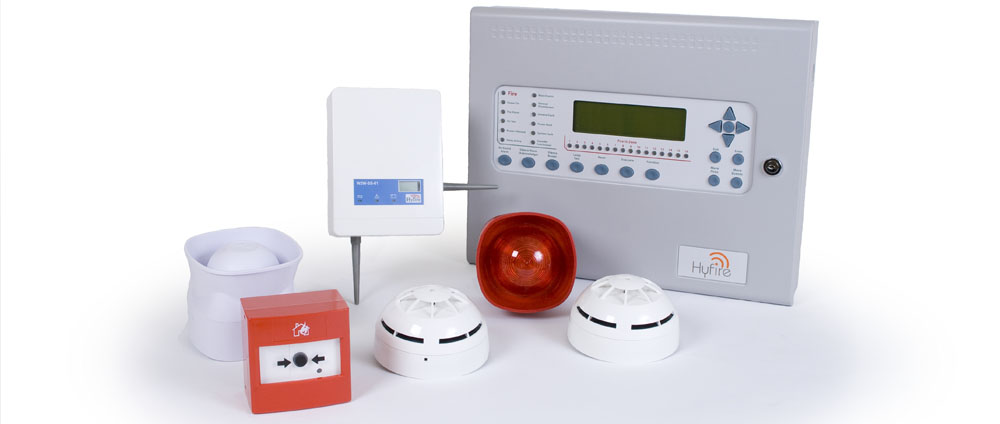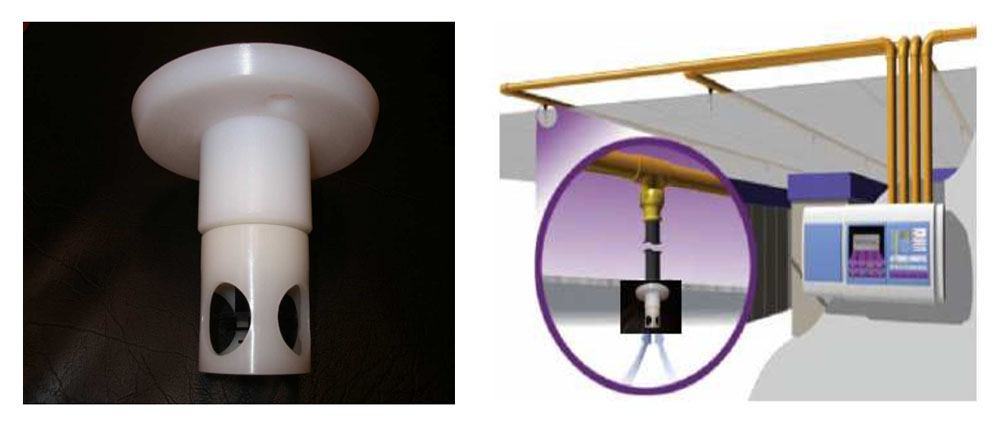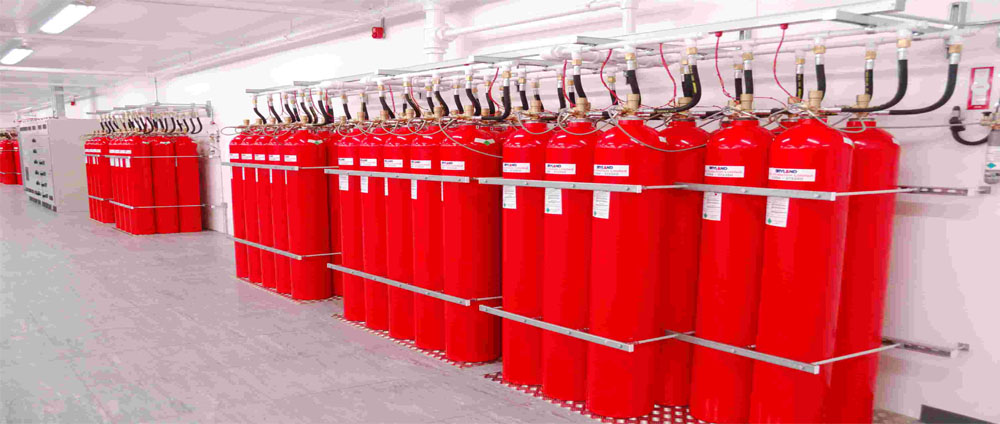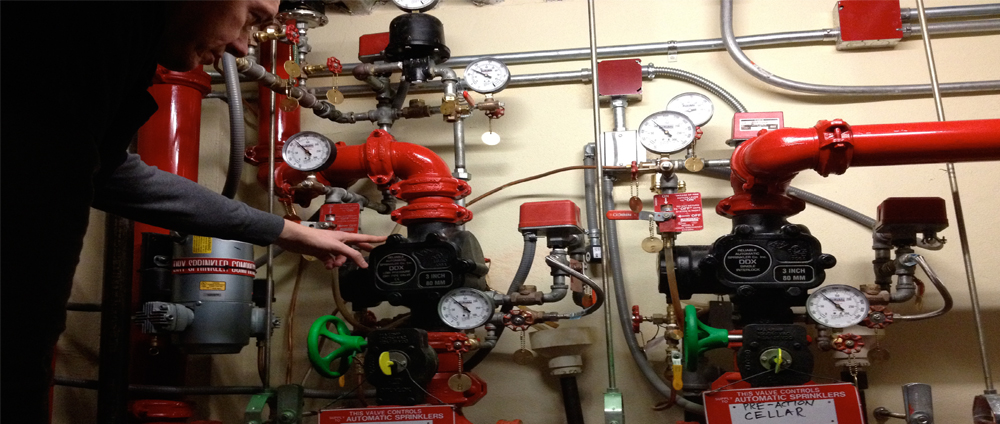- Details
-
Category: Water Mist
The Fike MicroMist system is a self contained,single fluid, pre-engineered water mist fire suppression system for total compartment protection of machinery spaces and compartmentalized gas turbine generators. The MicroMist system employs a brass nozzle which has demonstrated excellent performance extinguishing flammable liquid (Class B) fire scenarios. Each nozzle flows approximately 2.1 gallons/minute (8 liters/min) of water at 310 psi (21 Bar). A single Fike MicroMist system is capable of protecting areas up to 9175 ft3 (260 m3), with a maximum ceiling height of 16’ (4.9m).
The MicroMist system is offered in 70 and 112 gallon (267 and 423 liter) configurations. Each system package is skid mounted and includes all necessary valves and actuation components for system operation. System nozzles are ordered separately. Each MicroMist system package is pre-assembled and tested to ensure system reliability and simplify ease of installation.
Operating Principles
Water is an outstanding fire suppression agent due to its high heat capacity and latent heat of vaporization. The Fike Micromist system nozzle uses a plate to slice the small jets of water that flow through the nozzle orifice. The resulting water mist contains a variety of droplet sizes. The larger droplets produced by the nozzle provide the necessary energy and momentum to carry the smaller droplets to the base of the fire where the mist vaporizes and extinguishes the fire. The simple theory behind this development is that a large amount of small droplets have a greater surface area than the same volume of large droplets, therefore absorb more heat.
Water mist systems extinguish fires using the following basic principles:
- Cooling - As the mist is converted into vapor it removes heat from the fire source.
- Inerting - As the water mist turns to steam it expands approximately 1700 times, forcing oxygen away from the flame front, thus denying it the oxygen necessary to support combustion. (localize inert environment)
- Wetting - Primarily for incidental Class A fires; wetting of the surface helps extinguish the fire as well as contain it.
System Operation
When a fire condition is detected in a given protected hazard, the Fike control panel sends a signal to the releasing module to operate the Micromist suppression system. The water storage container is not under pressure until the system is actuated. The water container utilizes a 3/4” (20mm) brass valve to control the flow of water to the system nozzles. The water container has a drain/fill valve and a vent valve to drain the water when necessary. A safety disc is also fitted on the water container which ruptures if the pressure inside reaches a pressure greater than 500 psi (34 bar).
The Micromist system contains nitrogen cylinder(s) and a water cylinder. The nitrogen storage cylinder provides pressure to drive the water to the system nozzles. When the system is operated, valves on the nitrogen tanks open and the resulting air pressure flows through a pressure regulating valve (PRV) which regulates the pressure to 320 psi (22 Bar). This pressure drives the water through the opened water valve and to the system nozzles. The Micromist system uses relatively short pulses of water, called cycling, to aid in the extinguishment of fires as well as minimize the property damage associated with a continuous discharge.
System Components
The Micromist suppression system comes pre-packaged on a skid produced from 3/8” (9.5mm) thick steel plate. The water cylinder is bolted to the skid and the nitrogen cylinder(s) are mounted to the water cylinder with straps. The skid is designed so it can be easily transported with a fork lift.
The Fike Micromist system package is offered in 70 and 112 gallon (267 and 423 liter) configurations. The 70 gallon system consists primarily of one nitrogen cylinder and a water storage container. The 112 gallon system has two nitrogen cylinders and one water storage container. The nitrogen cylinders are charged to 1850 psi (128 bar) and fitted with a forged brass valve that is actuated with a solenoid valve. The solenoid valve is fitted with a pressure gauge (or optional switch) so the pressure inside the cylinder can be monitored.
The piping requirements for the Micromist system offer the flexibility of copper tubing type K or L, stainless steel tubing or pipe as specified in NFPA 750. Due to the low flow requirements of the Micromist nozzle it is not mandatory that the piping be balanced, which improves system flexibility. Consult the Micromist Design, Installation, and Maintenance Manual (P/N 06-153) for detailed piping limitations.
The Micromist system nozzles are constructed of brass and contain a nozzle screen to trap any debris that might be in the system piping. The nozzle utilizes a 1/2” (15mm) NPT port to connect to the piping network.
Applications
Micromist systems are designed and have been tested for use in protecting flammable liquid (Class B) processes and incidental combustible (Class A) materials.
The Fike Micromist system has successfully passed the Factory Mutual fire test protocol for machinery spaces, and compartmentalized gas turbine generators. The system will effectively extinguish flammable liquid pool fires as well as spray fires which could ignite from a ruptured hose or pipe in a process using flammable liquids. Micromist applications include, but are not limited to, the following:
• Compartmentalized gas turbine generators
• Engine test cells
• Generator rooms
• Machinery spaces with incidental storage of
flammable liquids
• Oil pumps
• Lubrication skids
• Diesel emergency rooms
• Fuel filters
• Diping, electrostatic coating or cleaning purposes
• Gear boxes
• Drive shafts
• Engine drive generators
• Chemical processes
• Flammable or combustible liquid pumps piping or
containers under pressure such as may be used with
hydraulic pumping equipment
Approvals











